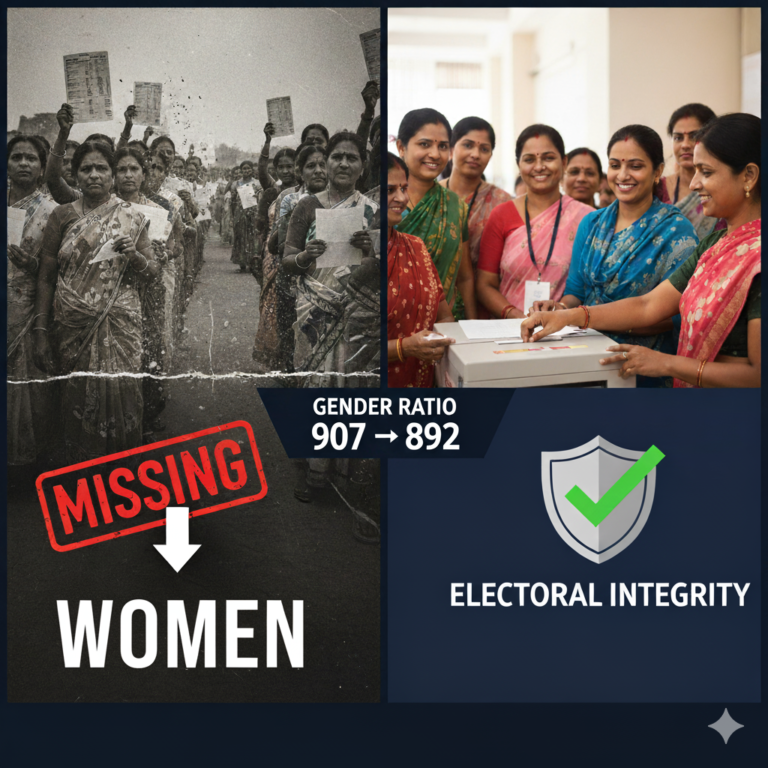Key Highlights
- FLFPR has risen from 23.3% in 2017–18 to 41.7% in 2023–24, but still trails global averages and G20 peers.
- Major barriers include inadequate safety infrastructure, rigid work norms, care burdens, wage gaps, and skill mismatches.
- Social norms and patriarchal attitudes limit women’s mobility and access to quality employment.
- Holistic solutions must integrate safe transport, flexible work policies, targeted vocational training, comprehensive care ecosystems, and strengthened social welfare.
- Coordinated public–private action and robust gender-sensitive policy implementation can unlock India’s “Viksit Bharat 2047” goal of 70% FLFPR.
Introduction
“Empowering women economically is not charity—it is smart economics.” This conviction underpins India’s urgent need to dismantle systemic gender barriers in the workforce. Despite India’s rapid growth, only 41.7% of working-age women participate in the labour force—well below the global average of 48.7% and OECD average of 67%. Addressing India’s persistent gender inequities requires holistic interventions spanning safety infrastructure, flexible employment norms, vocational training, and robust social welfare.
Background and Context
Persistently Low FLFPR
The Periodic Labour Force Survey shows female participation climbed from 23.3% in 2017–18 to 41.7% in 2023–24, driven largely by rural rises—from 24.6% to 47.6%—while urban rates nudged from 20.4% to 25.4%. Yet, India still lags comparable economies, with entrenched social norms, unpaid care burdens, and safety gaps holding many women back.
Root Causes of Gender Inequities
- Safety Infrastructure
- Rigid Employment Norms
- Absence of formal part-time or flexible contracts forces women to choose between career and care.
- Over 60% of female jobs are informal, lacking social security and benefits.
- Skills and Education Mismatch
- Although female literacy exceeds 70%, many lack industry-aligned skills.
- Drop‐out rates rise sharply post-marriage and childbirth, eroding skill retention.
- Unpaid Care Burden
Core Analysis
Social Perspective
Deep‐rooted patriarchal norms assign domestic roles to women, discouraging external work. Early marriage and motherhood further curtail career trajectories. Public campaigns and school curricula must challenge stereotypes, promoting shared household responsibilities.
Economic Perspective
IMF research estimates closing the FLFPR gap could boost GDP by 27%. Formalizing part-time work and redistributing unpaid care can raise FLFPR by up to six percentage points—from 37% to 43%. Flexible arrangements benefit both women and firms through increased retention and productivity.
Political Perspective
Recent Round Table discussions at LBSNAA highlighted coordinated policy design—combining labour reforms with safety measures and welfare top-ups—to achieve the Viksit Bharat 2047 vision of 70% female participation. Cross‐ministry collaboration is crucial for integrated implementation.
Ethical Perspective
Ensuring women’s right to safe, dignified work is a matter of social justice. Policies must safeguard against exploitation and harassment, while guaranteeing equal pay for equal work.
Technological Perspective
Digital platforms enable remote work and micro-tasking opportunities. E-commerce hubs can link rural women with urban markets. However, digital literacy and affordable internet access remain prerequisites.
Environmental Perspective
Green jobs—solar panel assembly, recycling, agroforestry—offer local employment in rural areas. Training women for sustainable livelihoods aligns gender equity with ecological sustainability.
Current Developments
- Safety Infrastructure: The Ministry of Women and Child Development’s Safe City projects aim to improve lighting, CCTV, and transport safety corridors in 20 cities.
- Flexible Norms: Model Shops and Establishments Acts piloting formal part-time contracts in Delhi and Karnataka.
- Skilling Initiatives: Government schemes like PMKVY and NAPS upskilled 1.2 million women in 2024, though placement rates remain below 50%.
- Social Welfare: The recently launched Creche Shakti Scheme provides on-site childcare in factories, benefiting 200,000 women to date.
Way Forward
1. Strengthen Safety Infrastructure
- Expand Safe City features nationwide, focusing on women-highway routes and industrial corridors.
- Partner with local NGOs to establish 24×7 helplines and rapid-response units.
2. Institutionalize Flexible Employment
- Amend labour codes to mandate pro-rated social security for part-time workers.
- Incentivize firms with tax breaks for adopting flexible scheduling and remote-work policies.
3. Scale Vocational Training
- Conduct geo-mapped skill‐needs surveys to tailor training for local industries.
- Forge public–private partnerships for guaranteed internships and placements.
- Develop mobile training units to reach remote communities.
4. Enhance Social Welfare
- Universalize maternity benefits and introduce paternity leave to promote shared care responsibilities.
- Build community crèches and elder‐care facilities under the Women’s Self-Help Group framework.
- Provide targeted cash transfers to women re-entering the workforce after childbirth or caregiving breaks.
5. Leverage Technology
- Launch a “Women@Work” digital platform aggregating flexible job listings, training modules, and grievance redressal.
- Subsidize broadband and smartphone access for women in underserved regions.
Conclusion
India stands at a pivotal juncture. Rising FLFPR demonstrates potential unlocked, yet systemic gender inequities persist. A holistic approach—integrating safety, flexibility, skills, and welfare—can transform India’s labour markets. Such interventions not only champion women’s rights but also catalyze inclusive economic growth, propelling India toward its Viksit Bharat 2047 vision. The time to act is now, for the benefit of women, families, and the nation.
Mains Questions
- “Analyse the multifaceted barriers to women’s workforce participation in India—especially in blue- and grey-collar sectors—and suggest policy interventions to address them.”
- “Discuss how transport inequality and caregiving responsibilities disproportionately affect women’s labour force engagement, particularly in urban and peripheral regions.”









+ There are no comments
Add yours